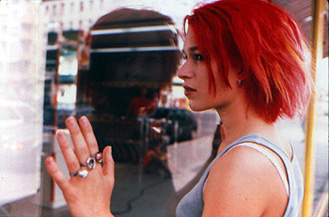Viking Night: Run Lola Run
By Bruce Hall
April 7, 2010
The story begins with a frantic phone call from Manni (Moritz Bleibtreu) to his girlfriend Lola (Franke Potente). He is a small-time gopher for a local hood who's been given a simple job to test his worthiness for bigger assignments. She is a chronically unemployed slacker, idling her way through life. Manni enlists her help for the drop, but thanks to an unfortunate blunder Manni loses the money he's collected and now has 20 minutes to somehow deliver $100,000 to his boss – or else. After a terse conversation, he concludes that his only option is to rob a nearby store to replace the missing cash.
Desperate to keep the situation from escalating further, Lola remembers that her father is manager of a bank. She dashes out the door toward his office, in hopes of borrowing enough money from him in time to save her lover's life. It's an intentionally simple premise, but over the next 20 minutes, Lola and Manni discover how the smallest actions can produce reverberations that profoundly affect the lives of many people. With the benefit of hindsight, all of us can see where we've made mistakes, and what we might have done to prevent them. But in the heat of the moment, in the midst of panic, our world compresses and the ramifications of haste are often impossible to foresee. On the surface, it's a small idea; an ordinary girl who's never accomplished anything suddenly has 20 minutes to raise enough money to save someone's life – but it's the biggest thing she'll ever have to do.
And it becomes something infinitely more important as the film examines how each step Lola and Manni take influences not only their own fates, but how brief interaction with several other characters causes them to run into one another over and over again, changing the lives of each in stark, contrasting ways. To this end, the film turns the traditional three act story arc on its head, giving Lola three "runs" in which to complete her task and telling three subtly different stories using the same characters and settings. It would be simple to dismiss this as lazy storytelling, but to do so would be to miss the entire point of the concept.
As Lola sprints through the streets of Berlin and Manni debates his next move, what seems to be meaningless interactions with supporting characters (five, in particular) turn out to have significant impact. On each "run," the decisions she makes cause her to arrive a split second late here, a split second early there – and the results echo through this circle of characters, creating a very different end for each scenario. Rarely do we consider how the most critical moments of our lives often boil down to a series of small coincidences entirely unknown to us, and if we had the chance to do it all again moving two steps to the left or two steps to the right might have changed everything!
But Tykwer gives the audience little time to openly dwell on the film's philosophical underpinnings. This is a story that is meant to be absorbed viscerally, right down to its title. And Lola does run, a lot, and we follow her as she makes her way across the city adorned with bright red hair, a disheveled Gen-X wardrobe and desperation painted across her face – pushing the pace of the film through force of will. The plot's urgency is augmented by an almost constant, pulsing trance soundtrack and an ever present sense of movement and visual definition. As is often pointed out, much of the film deliberately apes the feel of a music video, but where most music videos are frivolous nonsense, Lola uses melody, color and motion as discrete plot mechanisms to adjust the level of energy and to tell us subtle things about its characters.
Continued:
1
2
3
|
|
|
|




